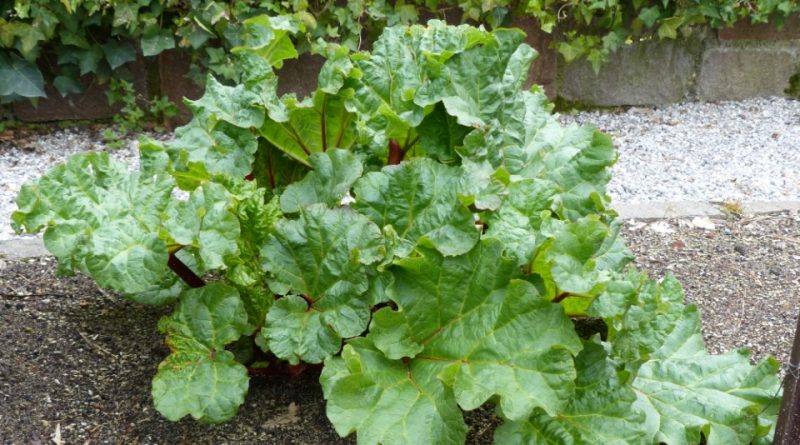Rheum officinale
Rheum officinale
The Chinese rhubarb (Rheum officinale L.) is a herbaceous species belonging to the Polygonaceae family.
Systematics –
From a systematic point of view it belongs to:
Eukaryota Domain,
Kingdom Plantae,
Magnoliophyta Division,
Magnoliopsida class,
Subclass Caryophyllidae,
Superorder Polygonanae,
Polygonales Order,
Polygonaceae family,
Polygonoideae subfamily,
Rheeae Tribe,
Genus Rheum,
R. officinale species.
The term is synonymous:
– Rheum baillonii F. Heim;
– Rheum officinale Baill ..
Etymology –
The term Rheum comes from the root rheu; par excellence rheu barbarum root of the barbarians, from which rhubarb.
The specific officinal epithet comes from a medieval laboratory workshop: plants usable in pharmaceuticals, herbal medicine, liqueurs, perfumery and the like.
Geographic Distribution and Habitat –
The Chinese rhubarb is a plant endemic to southeastern China, where it is found in the provinces of Guizhou, southwestern Henan, western Hubei, Shaanxi, Sichuan, Yunnan and possibly Fujian.
Its habitat is that of the undergrowth areas of hills and forests at altitudes of 1200 – 4000 meters in western China.
Description –
Rheum officinale is a perennial plant with a robust fleshy rhizome from which a new vegetative system is emitted every year that can reach heights even higher than 200 cm.
The leaves are large, mostly united in a basal rosette, arranged with alternating phyllotaxis, with long cylindrical and fleshy petioles and a flap that varies from ovate-cordate to kidney-shaped, simple or palmate-lobed. The margin is whole or toothed, more or less wavy.
The flowers are bisexual, gathered in long pedunculated terminal panicles which can reach a few decimetres in length. The individual flowers have a radiated symmetry, with a perigonium made up of six white or yellowish tepals. Stamens 6 or 9 in number. The ovary is larger, containing only one egg.
The fruit is a trigone walnut with prolonged edges in a membranous wing.
Cultivation –
Rheum officinale is a plant that has been harvested in nature for centuries for local use as a food, medicine and source of materials.
It lends itself easily to cultivation but prefers deep, fertile, moderately heavy soil, rich in humus, which retains humidity, well drained, in the sun or in partial shade; it also grows well in heavy clay soils.
Withstands temperatures down to about -20 ° C.
Plants can be grown spaced approximately 1.8 meters apart from each other in any direction.
The plant easily hybridizes with other members of this genus.
It is grown as a medicinal plant in China.
Propagation occurs by seed. Sowing must also be done in spring in unheated seedbeds.
The seedlings, in cold areas, should be grown in pots and transplanted the following year.
It can also be propagated by division in early spring or autumn. The rootstock must contain at least one shoot on each division. Larger divisions can be planted directly in their permanent locations.
Customs and Traditions –
Rheum officinale, in Chinese is called yào yòng gives huáng (Chinese: 药用 大黄), which literally means medicinal rhubarb. It is a plant that is used in traditional Chinese medicine. It is regarded as a kind of “cold” herb, used as a laxative in patients with constipation, sometimes accompanied by fever and even delirium. Rhubarb is thought to improve poor circulation, being particularly useful for removing body aggregates resulting from poor circulation.
Also in traditional Chinese medicine, R. officinale, in combination with a large variety of other herbs, has been used for the treatment of hepatitis B, although the results have been inconclusive.
This plant has a long and proven history of use as a herb; its main effect is a positive and balancing effect on the entire digestive system. It is one of the most used herbs in Chinese medicine.
The root is anti-cholesterol, antiseptic, antispasmodic, antitumor, aperient, astringent, cholagogue, emollient, diuretic, laxative, purgative, stomachic and tonic.
The roots contain anthraquinones, which have a purgative effect, and also tannins and bitter substances which have an opposite astringent effect.
According to a report, the plant contains 1.3% rutin; this does not specify which part of the plant, although it is likely to be the leaves.
When taken in small doses, it acts as an astringent tonic for the digestive system, while larger doses act as a mild laxative.
Preparation Method –
Rheum officinale is a plant which is used both in the food and above all in the medicinal field.
The foliar petiole is edible both raw and cooked. In Indonesia, especially Java, where it is known as klembak, it is usually dried and mixed with tobacco and incense to create a rokok klembak menyan, a traditional Javanese incense cigarette.
For medicinal use, the root is used. This is taken internally to treat chronic constipation, diarrhea, liver and gallbladder disorders, hemorrhoids, menstrual problems and skin rashes due to a buildup of toxins.
This remedy is not prescribed to pregnant or lactating women, nor to patients with intestinal obstruction.
Externally, the root is used in the treatment of burns.
The roots are harvested in October from plants that are at least six years old, then dried for later use.
From the dried root a homeopathic remedy is prepared which is used above all in the treatment of diarrhea in children in the teething phase.
Guido Bissanti
Sources
– Acta Plantarum – Flora of the Italian Regions.
– Wikipedia, the free encyclopedia.
– Useful Tropical Plants Database.
– Conti F., Abbate G., Alessandrini A., Blasi C. (ed.), 2005. An annotated checklist of the Italian vascular flora, Palombi Editore.
– Pignatti S., 1982. Flora of Italy, Edagricole, Bologna.
– Treben M., 2000. Health from the Lord’s Pharmacy, Advice and experiences with medicinal herbs, Ennsthaler Editore.
Photo source:
– http://dryades.units.it/dryades/plants/foto/TS137570.jpg
Warning: Pharmaceutical applications and alimurgical uses are indicated for informational purposes only, they do not represent in any way a medical prescription; therefore no responsibility is taken for their use for curative, aesthetic or food purposes.


